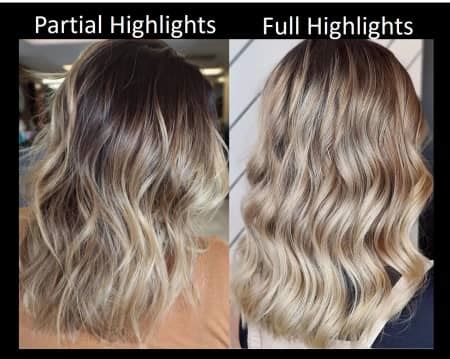Introduction
Highlights are a popular hair coloring technique that can add dimension and brightness to your locks. But when it comes to choosing between partial and full highlights, there are several factors to consider. This comprehensive guide explores the differences between these two techniques, their costs, benefits, and maintenance requirements to help you make an informed decision.

What is the Difference Between Partial and Full Highlights?
Partial Highlights:
- Focus on specific sections of the hair, such as the top layers or around the face.
- Create a subtle, sun-kissed effect without drastically altering the overall hair color.
- Typically use fewer foils and require less bleach, making them more affordable and less damaging.
Full Highlights:
- Cover the entire head of hair from roots to ends.
- Provide a more dramatic lightening effect that can significantly change your base color.
- Require more foils, bleach, and time to apply, resulting in higher costs and potential hair damage.
Benefits of Partial Highlights
- Natural Look: Create a gradual transition from dark roots to lighter ends, mimicking the natural sun-bleached effect.
- Versatile: Can be customized to enhance specific facial features or create a flattering frame around the face.
- Low Maintenance: Requires less frequent touch-ups than full highlights, as the focus is on the regrowth at the roots.
- Protective: Use less bleach than full highlights, reducing hair damage and preserving its health.
Benefits of Full Highlights
- Dramatic Transformation: Provide a bolder, more noticeable lightening effect that can significantly alter your hair color.
- Even Color Distribution: Ensure uniform lightening across the entire head of hair, resulting in a cohesive look.
- Glamorous Effect: Create a salon-quality, high-contrast look that is perfect for special occasions or those seeking a more dramatic change.
Cost Comparison
The cost of partial and full highlights varies depending on the length and thickness of the hair, as well as the salon and geographical location. On average:
| Type of Highlights | Estimated Cost |
|---|---|
| Partial Highlights | $100-$250 |
| Full Highlights | $150-$400 |
Maintenance Requirements
Both partial and full highlights require regular touch-ups to maintain their desired color.
Partial Highlights:
- Touch-ups every 8-12 weeks
- Focus on regrowth at the roots
- Less frequent and less expensive than full highlights
Full Highlights:
- Touch-ups every 4-8 weeks
- Redo the entire bleach and toner process
- More frequent, time-consuming, and expensive than partial highlights
Strategies for Choosing the Right Technique
Consider the following factors when selecting between partial and full highlights:
- Desired Effect: Do you want a subtle, sun-kissed look or a more dramatic transformation?
- Hair Condition: Partial highlights are less damaging for delicate or color-treated hair.
- Time and Budget: Full highlights require more time and are more expensive than partial highlights.
- Maintenance: Partial highlights require less frequent touch-ups and are easier to maintain.
- Personal Style: Both techniques can complement different hair types and personal styles.
Common Mistakes to Avoid
- Over-Highlighting: Too many highlights can result in a brassy or damaged appearance.
- Bleaching Too Frequently: Excessive bleaching can weaken and compromise the hair’s health.
- Using the Wrong Tone: Choose a toner that complements your skin tone and overall hair color to avoid unwanted undertones.
- Ignoring Root Touch-Ups: Neglecting touch-ups will create a noticeable contrast between the regrowth and the highlighted hair.
- Failing to Protect the Hair: Use heat protectant and color-safe products to minimize damage from heat styling and environmental factors.
Conclusion
Whether you choose partial or full highlights, selecting the right technique is crucial for achieving your desired look. By understanding the differences between these two techniques, their costs, benefits, and maintenance requirements, you can make an informed decision that aligns with your individual needs and preferences. Remember to consider hair condition, style, budget, and maintenance when deciding on the best approach for your hair.
